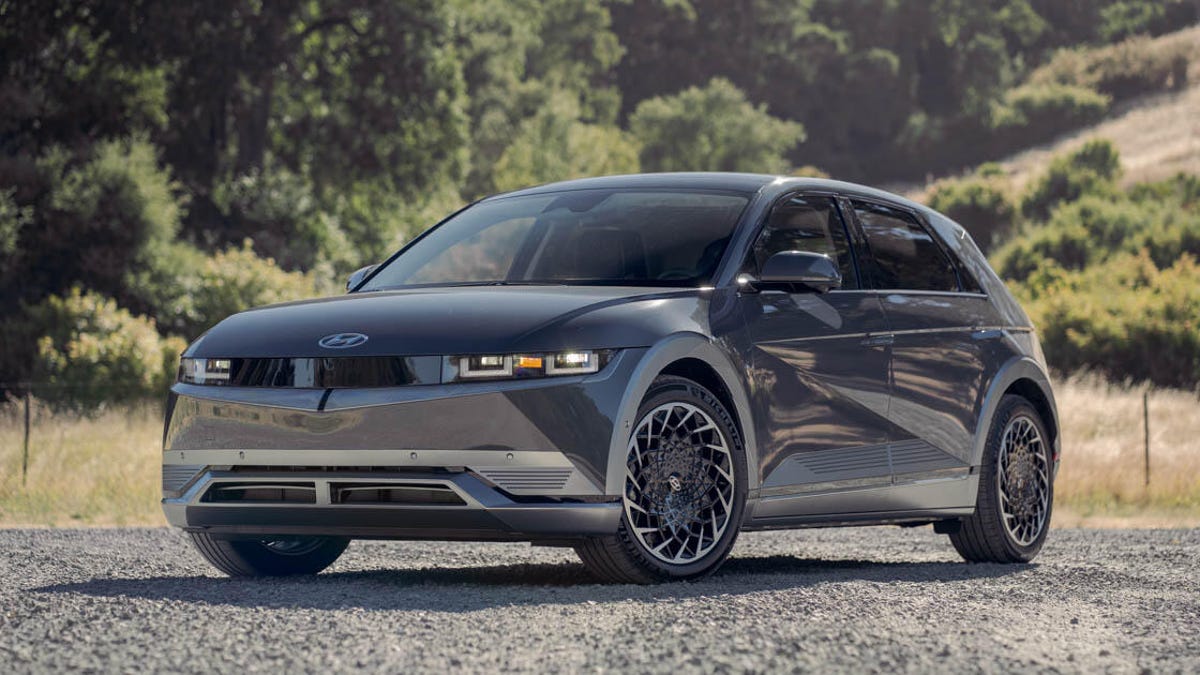Pros
- Flexible V2L feature enables 120V power output to external devices and appliances
- Full-featured suite of driver aid tech with clever remote parking function
- One of the fastest charging EV’s we’ve tested with excellent range to match
Cons
- No wireless support for Apple CarPlay, Android Auto
- “Frunk” underhood bin only really good for charging cable storage
- Does not currently qualify for federal plug-in incentive
Leading Hyundai Motor Group’s charge into the electric age is the sharply styled Hyundai Ioniq 5. After wowing me with its angular aesthetic and pixelated light details when it debuted in 2021, the automaker’s first dedicated battery-powered model followed up with an impressive first drive experience and has been one of my favorite affordable EVs ever since.
Bolstered by its excellent range, fast charging and smart looks — along with familiar technologies inherited from the automaker’s popular line of combustion and hybrid-powered cars — the Ioniq 5 is an easy, low-anxiety option for drivers looking to transition to full-electric mobility. Plus, this is one of the few EVs available today that, with the addition of an inexpensive adapter, is capable of bidirectional charging, a feature that adds utility, flexibility and energy security in a manner unmatched elsewhere in the automotive world.
Performance, range and efficiency
Depending on the trim level chosen, the 2024 Ioniq 5 rolls out with one of two battery options. At the entry point SE Standard Range spec, the EV features a 58 kilowatt-hour pack. That powers a single 125-kilowatt (225 horsepower) e-motor driving the rear wheels to the tune of 258 pound-feet of torque. The instantaneous way the EV delivers that torque nets you more than sufficient pep for responsive and nimble-feeling performance around town and on the highway. The lightest configuration in the line, the Standard Range model cruises at an estimated 3.3 miles per kilowatt-hour, but the number you’re probably most interested in is the 220 miles of EPA-estimated range per charge.
SE Long Range, SEL and Limited models all step up to a larger 77.4 kWh battery and a more powerful 168 kW (225 hp) rear motor. Total torque is unchanged (still 258 lb-ft,) so acceleration feels about the same around town and off the line, but more overall top end power means a bit more oomph for improved highway performance and response. The heavier, more capacious battery is both a touch more efficient on the EPA’s test cycle at 3.4 mi/kWh and longer-ranging at 303 miles per charge. The bigger battery is, no surprise, better.
Long range RWD is, I reckon, the sweet spot configuration, but the upper trim levels can be further upgraded to all-wheel drive, bringing a second 74-kW motor to the party to drive the front wheels. With both axles at full-chooch, power increases to around 320 hp and torque to 446 lb-ft, significantly improving acceleration — now 4.4-seconds to 0-60 mph versus the 7.4 ticks for the single motor spec — and adding a bit of extra surefootedness in rainy or snowy conditions. The front motor is on-demand, meaning the it automatically decouples when not needed to preserve range. (It can also be manually deactivated by selecting the Eco drive mode.) Even so, AWD comes at a cost, reducing estimated efficiency to 2.9mi/kWh and range to 260 miles per charge.
The Ioniq 5 is one of the fastest-charging EV’s I’ve tested, able to optimally DC rapid charge from 10% to 80% in around 18 minutes at an 800-volt station supplying at least 250 kW. Of course, actual time plugged in depends on the battery condition, the ambient temperature, the capabilities of the charger and other factors. In practice, almost none of the stations near me were able to peak higher than 227 kW, and my fast charge sessions averaged between 20 and 30 minutes — still pretty quick.
All-wheel drive is on-demand, meaning the front motor can deactivate to preserve range during light cruising.
Level 2 home charging supports up to 10.9 kW, taking just under 6 hours to go from 10% to 100% for the smaller battery or 7 hours and 10 minutes for the Long Range pack. Hyundai has announced future compatibility with Tesla’s NACS standard (likely via an adapter), but the details of when and how we can expect this capability to come to the Ioniq 5 specifically have not been announced/finalized. Until then, drivers can use charging stations compatible with the CCS/J1772 charging port behind the standard motorized charging door.
V2L bidirectional power
One of the coolest party tricks made possible by the Ioniq’s EV platform is vehicle-to-load power delivery. This bidirectional power technology allows the owner to use a relatively inexpensive adapter to convert the J1772 charging input to a NEMA 5-15 AC output. Users can then plug any AC-powered device or appliance they wish into this normal home-type outlet as long as they don’t exceed the 1.8 kW maximum draw.
That’s not enough continuous juice to power your whole home like, say, Ford or Chevy’s vehicle-to-home setups or a stationary battery installation could, but there’s enough capacity to keep a refrigerator or chest freezer running for a few days, which could save a lot of food spoilage in areas where power outages are frequent.
Software on the Ioniq 5’s dashboard allows a user to activate or disable V2L and set battery capacity reserve limits in 10% increments so you’ll still have enough range to get home or to a charger after a day of tailgating or powering a campsite. The Limited trim level adds a second 15-amp 120-volt outlet to the cabin beneath the back seats for additional AC power capacity or for charging devices (laptops, tablets, etc.) on the go.
Watch this: Hands-on: V2L Turns Kia, Hyundai EVs Into Emergency Generators
Dual-screen cabin tech
The Ioniq 5’s dual 12.3-inch screens are identical in size and resolution but differ in functionality. The left display serves as the digital instrument cluster, home to speed, battery and range information, as well as a host of customizable EV info toggled by buttons on the steering wheel. The right-side touchscreen is home to the main infotainment interface, which is intuitively organized and — aside the addition of a few EV-specific menus — largely identical to the UI you’ll find in any of Hyundai Motor Group’s combustion or hybrid cars.
Onboard navigation works well, integrating real time range and charging station data into trip planning, but users have the option to power their ride with Google Maps, Apple Maps or Waze thanks to standard Android Auto and Apple CarPlay connectivity. Annoyingly, only wired connections are supported for smartphone mirroring — you’ll have to use vanilla Bluetooth if you want to go wireless — which somewhat limits the usefulness of the Ioniq’s wireless phone charging pad.
Much of the onboard tech is powered by the BlueLink+ onboard cellular data connection, including connected destination search, live charging station data, remote vehicle monitoring, charge scheduling and more. I was pleased to learn that for the 2024 model year and newer, BlueLink+ is complementary, so you shouldn’t have to worry about renewing a subscription after three years to keep the expected level of functionality, as was the case with previous model years. That is, unless you want to use the Wi-Fi Hotspot function, which isn’t included and charged separately.
Aside from a few design quirks, the Ioniq 5’s dashboard interface and software don’t stray too far from that of its familiar combustion and hybrid-powered cars.
The aforementioned tech is all standard equipment right down to the base spec, but upgrading to the SEL trim level adds a few bells and whistles, including the Hyundai Digital Key feature that allows a compatible iPhone or Android phone to replace the key fob to unlock and start the vehicle with NFC technology. Step up again to the Limited spec to add a head-up display that projects vehicle information onto the windshield, a massive sunroof and extended recline for the driver’s seat with an extending ottoman, so you can kick back and stretch out while waiting for a charge to complete.
Driver aid and parking tech
It’s nice to see what was once expensive tech add-ons becoming standard driver aid technology, as is the case with the Ioniq 5’s SmartSense safety suite. This rolls in Highway Driving Assist (HDA1) adaptive cruise control with Lane Keeping Assistance steering which, along with Forward Collision Avoidance braking assist, boost safety and reduce fatigue during longer drivers. Also standard are blind spot monitoring with haptic steering wheel vibration if you’re about to merge into an occupied lane, rear parking distance sensors and cross traffic alerts and the now legally mandated rear-view camera.
Upgrading to the SEL trim level also upgrades to an improved version of Highway Driving Assist (HDA2) with smarter stop-and-go logic and more natural spacing with vehicles in adjacent lanes (rather than just locking onto center) thanks to the addition of “machine learning.” SEL also gets more parking distance sensors and smarter forward collision avoidance that now looks for cross-traffic in junctions,
At the top of the line, the Ioniq 5 Limited features a surround-view camera system that helps with precision parking and a feature called Blind Spot View Monitor that shows a camera view of the adjacent lane in the instrument cluster when activating the turn signal. Raised to look over my shoulder when signaling to change lanes, I barely noticed or made use of the blind spot cam, but I could see it coming in handy for seating positions with less than optimal visibility.
Hard geometric lines and pixelated details set the Ioniq 5 apart from a sea blob-shaped electric cars.
The Limited spec also adds Remote Smart Parking Assist, the Ioniq 5’s coolest, but most situational convenience feature. After exiting the vehicle and activating remote start, drivers can hold a button on the key fob to remotely move the EV forward or backward in or out of a parking space. The Ioniq can move in a straight line and only when the driver is within a few feet of the car and no obstructions are detected by the parking sensors. This is useful if, say, someone parks too close to you, just remote out of the space and get in once the door clears. I loved using the feature to squeeze the EV in and out of my claustrophobic garage, which is too narrow to easily open the doors after backing in. However, aside from a few edge cases, it’s mostly a very cool party trick that I can’t imagine using much in public.
Price, availability, recommended options
The 2024 Hyundai Ioniq 5 starts at $43,195 for the base SE Standard Range spec (including the requisite $1,395 destination charge) with 220 miles of range. That’s not bad if your daily range needs are modest and you live in an area with mild weather year-round. However, if you like to take longer trips (or live in an area with range sapping hot summers or cold winters), I’d recommend treating the 303-mile, $47,245 SE Long Range as the better entry point to the line up.
The SEL adds a few nice-to-have creature comforts, including a hands-free power liftgate, machine learning driver aid tech and Phone As Key tech for $49,795. Finally, the top-spec Limited climbs to $55,895 pushing the limits of the price range but adding cool and useful features like Remote Smart Parking Assist, a head-up display and surround cameras.
For most drivers, I recommend sticking with the SE Long Range RWD. The Ioniq’s standard loadout is fully featured enough that I doubt most drivers would miss the more advanced options. I also recommend skipping the $3,500 upgrade to AWD unless you live in an area with slippery conditions for most of the year. This configuration maximizes range and efficiency, saving money up front and over the long term.
Hyundai has plans to bring Ioniq 5 assembly and battery production online at its new Georgia plant, which could qualify it for the $7,500 federal BEV/PHEV tax credit. However, at time of publication, the EV is an import and doesn’t make the cut. (Though, it may qualify for the federal leasing incentive.) We’ll update the review to reflect when the status changes.
The top-spec Limited model features the most tech and creature comforts, including this Relax-mode extended recline driver’s seat and ottoman.
You should avoid the 2024 Ioniq 5 if…
As good as the Ioniq 5 is, it’s about to get just a little bit better. The automaker recently updated the EV in its home Korean market and it’s a safe bet that we’ll be seeing a mid-cycle update landing sometime in the next year. Expect minor aerodynamic improvements and a larger Long Range battery pack (84.0 kWh). If you don’t need to pull the trigger on a new EV today, waiting a few months could net you a range boost of 8% to 10% (or at least a better deal on the current model.) Patience could also see tax incentives coming online with Hyundai’s Georgia assembly plant later this year.
Larger than it looks in photos, the Ioniq 5 is classified by the EPA as a “small SUV” but it’s only packing as much cargo volume as a large hatchback without the benefit of a large front “frunk” like Tesla’s Model Y. Drivers picking up what the Ioniq 5 is putting down but with a need for more seats for souls and trunk for their junk should consider the three-row Kia EV9 (built on the same EV platform and technology) or hold their horses for the upcoming Ioniq 7.
You can find even more EV options of all shapes, sizes and budgets in our Best EVs of 2024 buyers guide.
You should consider the 2024 Ioniq 5 if…
With super fast charging and ample range, the Ioniq 5 affords it a lot of flexibility and resistance to anxiety on longer trips. The high level of standard tech takes a lot of the guesswork out of choosing options, while the tried and true user interface keeps that tech from getting too distracting. The Ioniq 5 is an EV that gets the basics of being an electric car right, making it a very easy EV to live with — which I know firsthand after living a whole year with its near-identical platform-mate, the Kia EV6.
I especially dig the Ioniq’s angular style; it’s avant garde, but so weird looking you’d be embarrassed to step out of it. Plus, my brain continuously bristles with ideas for this things I could power at a campsite or tailgate party when its uniquely approachable V2L system is mentioned. Hyundai’s Ioniq 5 continues to be one of my favorite, most easily recommended EVs for the money.
Vehicle Scoring Matrix: 2024 Hyundai Ioniq 5
| Performance (35%) | 9 |
|---|---|
| Media (25%) | 9 |
| Features (20%) | 8 |
| Design (20%) | 10 |
| Overall | 9 |
How we test electric cars
I’ve evaluated hundreds of conventional and electrified cars over the past 16 years, but the process always starts behind the wheel in real-world conditions on public roads. For each car I test, I cover over 200 miles on a mixed driving route that includes dense urban roads, long stretches of highway and some twisty mountain roads mixed in for fun and flavor.
For EVs, I keep a close eye on the electric range and the charging experience, taking into account differences between any available drive modes, such as eco, sport or comfort modes. Factoring this alongside the driving dynamics (handling, acceleration and braking), I compare each vehicle to the competition in its class and models often cross-shopped to get the Performance score.
Along the way, I also check each car’s cabin comfort, dashboard tech and driver aid and safety features (Design, Media and Features, respectively) to get a feel for where each vehicle fits in my experience testing hundreds of combustion, hybrid, hydrogen and, yes, battery-powered cars for CNET reviews.
-
Performance: The efficiency, range and charging experience of an electrified vehicle, factoring in driving dynamics and comfort relative to other vehicles in a specific class.
-
Media: The quality of the infotainment and dashboard technology, checking that desirable features (such as Apple CarPlay and Android Auto) are present, but also evaluating ease of use and organization, especially while in motion.
-
Features: Driver assistance and safety technologies, both standard and optional, are weighed for our Features score. We check that desirable features are available, but also how well they work relative to industry standards and competing models.
-
Design: Ergonomics, cabin comfort, available storage and more factor into the Design score. Unique features that make life easier and, to a degree, aesthetics also contribute to this category.


